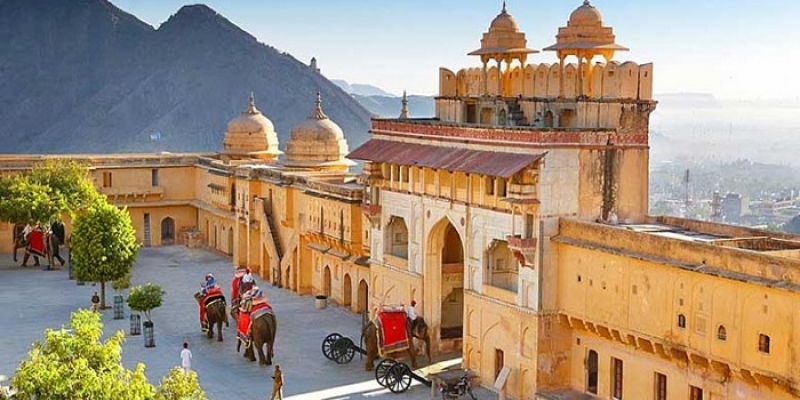Masterpieces that Showcase the Diversity in Indian Architecture
Best Archicture in India, Discover the rich tapestry of Indian architecture through masterpieces that highlight the country's diverse cultural heritage, blending ancient traditions with contemporary styles in awe-inspiring structures in India. Know more
Best Architecture in India
India has been a land of architectural masterpieces and visitors from different parts of the world come to this holy land to witness the beauty and intricacy of magnificent Indian architecture. From temples to mosques and other historic sites, there are lots of signature structures in India that are second to none. Most of these monuments are known for their exquisite detailing and architectural style. The one thing common among them is their ability to exhibit the diversity of Indian architecture like nothing else. A large number of visitors from different corners of the globe come to become a witness of the rich tale of India’s supremacy in the field of ancient architecture through these astonishing monuments.
Let’s get to know more about them in the following part.
1. AMBER FORT, RAJASTHAN
Amber Fort is one of the forts in Rajasthan that are situated on hills. A sample of Hindu architecture built in a Rajputana style, this fort is 11km away from the city of Jaipur. Built with Red-Sandstone and Marble, it is widely known for its self-reliant features. Moata Lake is the perpetual water source for the fort and its very advanced ventilation system is supported by outstanding design. The entire construction is a protruding display of the royalty as well as the enriching cultural heritage of Rajasthan.

2. SUN TEMPLE, KONARK
Located in the coast of Bay of Bengal in Odisha state, it is considered one of the finest examples of Dravidian Architecture. Also called the Black Pagoda, it is considered as one of the biggest temples in India. Constructed in the 13th century, its design is like a giant chariot with twelve knottily crafted wheels led by seven horses. A true prodigy that reveals the high-level craftsmanship as well as love and devotion of that era for art.

3. SANCHI STUPA
The first and most central of Buddhist architectural memorials, the Buddhist stupa acts as a sign for a sacred space, a symbolic depiction of the Buddha’s burial mount. The Great Stupa at Sanchi, in central India, is one of the most primitive stupas; it served as an architectural example for all others that followed. The world-known stupa — first built by the 3rd century BCE Mauryan ruler Ashoka in brick — was later prolonged to twice its initial size in stone.

4. THIKSE MONASTERY
Thiksay Gompa, Thiksey Monastery or Thiksay Monastery is basically a gompa of Tibetan Buddhism belief. It is situated on the top of the hill. It is extremely popular for its resemblance to Potala Palace of Lhasa. This monastery is well-known for pilgrim actions, architectural essentials, sightseeing, and exploration. The monastery has a stimulating story of how it was constructed in such a great location. It is believed that when two Buddhist monks offered prayers and rituals at the Yellow Temple and were about to offer a cake to the God into the valley, a crow took away the cake and place it on a hilltop. They supposed this a divine instruction and built a monastery on that hill.
5. CHAND BAORI
Built in the 9th century, Chand Baori is one of the world’s largest and oldest stepwells. It was constructed to save water and give relief from the strong heat of Rajasthan. It was an environmental and community meeting place for locals as well as royals. Chand Baori an Architectural masterwork and features 3.500 symmetrical narrow steps that go down. The histrionic architecture of the Chand Baori and its abandoned location also makes it a preferred place for film shooting like “Dark Knight Returns”, where Bruce Wayne made an attempt for a dangerous climb to escape his imprisonment and return to protect Gotham.
6. AJANTA-ELLORA CAVES
Built between 2nd century B.C. to 6th century A.D., these caves are the great specimens of rock-cut caves. Carved out of volcanic ballistic formations in a linear pattern, there are 34 caves, comprising of the leftovers of Buddhist, Hindu, and Jain temples. These walls are fortified with engravings showing the lifespan of Lord Buddha. The objective of these caves was to build a sanctuary for the monks to ponder. Ellora is quite popular for being the world’s largest monolithic excavation leading to the discovery of the great Kailas a temple.
7. LOTUS TEMPLE
The Baha'i House of Worship, prevalently known as the Lotus Temple is not only a sign of brilliance in modern Indian architecture but also one of the most visited religious structures in the world. The design of this building is based on the shape of the lotus, a flower considered sacred by most Indians. The building is made up of three levels of nine petals each, springing from a podium that raises the building above the nearby plain. The first two ranks bend inward, covering the inner dome, while the third layer curves outward to create canopies over the nine entrances.









